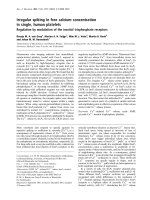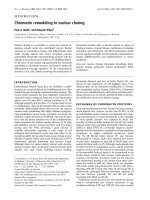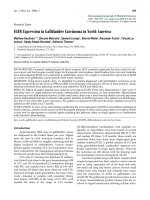Báo cáo y học: "Beta-lactam antibiotics in continuous infusion in critically ill patients" pdf
Bạn đang xem bản rút gọn của tài liệu. Xem và tải ngay bản đầy đủ của tài liệu tại đây (117.83 KB, 2 trang )
We read with great interest Taccone and colleagues’
article [1], published in a recent issue of Critical Care, on
the insuffi cient β-lactam concentrations in the early
phase of severe sepsis and septic shock. While we fully
agree with the authors’ fi ndings, we would like to off er
some remarks.
Only 18 of their 80 patients (22.5%) were infected with
Pseudomonas aeruginosa, but Taccone and colleagues
used the European Committee on Antimicrobial Suscep-
tibility Testing (EUCAST) minimal inhibitory concen-
tration (MIC) breakpoints of P. aeruginosa to calculate
the target pharmacokinetics (PK) profi le in all of the
patients. Because Enterobacteriaceae form a substantial
part of infectious organisms in intensive care patients, it
would be interesting to see how many patients would
attain the PK profi le for these microorganisms [2]. For
cefepime, for instance, if the EUCAST sensitivity thres-
hold of 1 mg/L were used, 17 of 19 patients (89%) would
attain the target PK profi le as compared with 3 of 19
patients (16%) for P. aeruginosa. Of course, we agree that,
in an empirically started antibiotic regimen, the organ-
isms, let alone the MIC, are not known to the clinician.
Furthermore, the data of Taccone and colleagues
should be interpreted in light of local epidemiology and
resistance data. In a Belgian multicenter study, all
P. aeruginosa strains isolated from patients hospitalized
in the intensive care unit (ICU) had an MIC
90
(MIC
required to inhibit the growth of 90% of organisms) for
meropenem of 0.12 mg/L [3]. With this MIC, even more
than 75% of the patients would have attained the target
PK profi le. In addition, we think that the initial loading
dose should be followed immediately by an extended or
continuous infusion in order to obtain an optimal PK/
pharmacodynamics (PK/PD) profi le [4].
© 2010 BioMed Central Ltd
Beta-lactam antibiotics in continuous infusion in
critically ill patients
Axel Jeurissen*
1
and Robert Rutsaert
2
See related research by Taccone et al., />LETTER
*Correspondence:
1
Department of Medical Microbiology, GZA St. Vincentius, St. Vincentiusstraat 20,
2018 Antwerp, Belgium
Full list of author information is available at the end of the article
Authors’ response
Fabio Silvio Taccone, Jean-Louis Vincent and Frédérique Jacobs
We thank Jeurissen and Rutsaert for their interest in our
study [1] and would like to reply to the important points
they raise. In our patient population, one third of docu-
mented infections were due to P. aeruginosa as micro-
biological samples remained negative in 30% of patients
with sepsis. Indeed, P. aeruginosa is frequently isolated in
patients with comorbid illnesses or indwelling catheters
or who are on mechanical ventilation or under going
surgery, all of these conditions being typical in ICU
patients [5]. Pseudomonas infections are associated with
the highest mortality rate in this ICU patient population.
For all of these reasons, it seems logical to develop an
empirical strategy that targets this pathogen in patients
with nosocomial infections.
We agree that in vitro studies on Pseudomonas suscep-
tibility may show MICs that are much lower than the
upper threshold of sensibility proposed by the EUCAST
for carbapenems. However, in all epidemiologic studies,
only the fi rst isolated strain of P. aeruginosa is considered
for MIC determination. Besides having an intrinsic
resistance to a wide range of antimicrobials, Pseudo mo nas
is able to acquire resistance via several mechanisms or
under antimicrobial pressure. A recent study showed that
Pseudomonas strains isolated from ICU patients are able
to progressively increase the in vitro MIC level to
diff erent antibiotics during therapy [6].
Finally, we agree that the extended or continuous infu-
sion of β-lactams can optimize the PK/PD profi le of these
drugs. Unfortunately, as only retrospective studies have
provided evidence in favor of continuous infusion over
intermittent infusion (especially in pathogens with higher
Jeurissen and Rutsaert Critical Care 2010, 14:446
/>© 2010 BioMed Central Ltd
MICs and in ventilator-associated pneumonia [7]), a pros-
pective study in this setting is warranted.
Abbreviations
EUCAST, European Committee on Antimicrobial Susceptibility Testing;
ICU, intensive care unit; MIC, minimal inhibitory concentration; PD,
pharmacodynamics; PK, pharmacokinetics.
Competing interests
FST, FJ, and J-LV have received lecture honoraria from AstraZeneca (London,
UK). J-LV is on the speakers’ list of GlaxoSmithKline (Uxbridge, Middlesex, UK).
The other authors declare that they have no competing interests.
Author details
1
Department of Medical Microbiology, GZA St. Vincentius, St. Vincentiusstraat
20, 2018 Antwerp, Belgium.
2
Department of Intensive Care Medicine, GZA St.
Vincentius, St. Vincentiusstraat 20, 2018 Antwerp, Belgium.
Published: 26 October 2010
References
1. Taccone FS, Laterre PF, Dugernier T, Spapen H, Delattre I, Witebolle X, De
Backer D, Layeux B, Wallemacq P, Vincent JL, Jacobs F: Insu cient β-lactam
concentrations in the early phase of severe sepsis and septic shock. Crit
Care 2010, 14:R126.
2. Vincent JL, Rello J, Marshal J, Eliezer S, Anzueto A, Martin CD, Moreno R,
Lipman J, Gomersall C, Sakr Y, Reinhart K for the EPIC II Group of Investigators:
International study of the prevalence and outcomes of infection in
intensive care units. JAMA 2009, 302:2323-2329.
3. Belgian Isepamycin Multicentre Group: Comparative in vitro activity of
isepamycin and other antibiotics against gram-negative bacilli from
intensive care units (ICU) in Belgium. Acta Clin Belg 2001, 56:307-315.
4. Roberts JA, Lipman J, Blot S, Rello J: Better outcomes through continuous
infusion of time-dependent antibiotics to critically ill patients? Curr Opin
Crit Care 2008, 14:390-396.
5. Page MG, Heim J: Prospects for the next anti-Pseudomonas drug. Curr Opin
Pharmacol 2009, 9:558-565.
6. Riou M, Carbonnelle S, Avrain L
, Mesaros N, Pirnay JP, Bilocq F, De Vos D,
Simon A, Piérard D, Jacobs F, Dediste A, Tulkens P, Van Bambeke F, Glupczynski
Y: In vivo development of antimicrobial resistance in Pseudomonas
aeruginosa strains isolated from the lower respiratory tract of intensive
care unit patients with nosocomial pneumonia and receiving
antipseudomonal therapy. Int J Antimicrob Agents 2010 Oct 4. [Epub ahead
of print].
7. Lorente L, Jiménez A, Palmero S, Jiménez JJ, Iribarren JL, Santana M, Martin
MM, Mora ML: Comparison of clinical cure rates in adults with ventilator-
associated pneumonia treated with intravenous ceftazidime
administrated by continuous or intermittent infusion: a retrospective,
nonrandomized, open-label, historical chart review. Clin Ther 2007,
29:2433-2439.
doi:10.1186/cc9288
Cite this article as: Jeurissen A, Rutsaert R: Beta-lactam antibiotics in
continuous infusion in critically ill patients. Critical Care 2010, 14:446.
Jeurissen and Rutsaert Critical Care 2010, 14:446
/>Page 2 of 2









